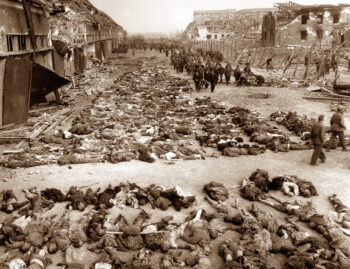Nordhausen
The Dora-Mittelbau Camp, located a few miles northwest of the city of Nordhausen, was the nucleus of a network of forced-labor camps in and around the Harz Mountains in Thuringia, Central Germany. It served primarily to provide a slave-labor force to factories of Germany’s defense industries. Among them featured most prominently the underground production facilities of the so-called V Weapons (Vergeltungswaffen, retaliation weapons), meaning the V-1 cruise missiles and the V-2 ballistic missiles.
As former Dora inmate Paul Rassinier has aptly described, the living and working conditions in that camp were at times horrific (Rassinier 2022). This is particularly true for the final months of the war, when SS men were increasingly unnerved by Germany’s impending collapse, and when neither Germany’s civilian population nor any camp population could be provided with appropriate food, shelter, clothing, medical care, drinking water etc. The scenes well-documented on film and photo about the Bergen-Belsen Camp were not much different in many other camps, Dora included.
In that context, on 8 January 1945, the SS took control over a military barracks of the German air force, the Boelcke-Kaserne in the city of Nordhausen near the Dora factories. It subsequently served as a holding facility for all inmates of the Dora camp system who were no longer fit for work. The barracks were soon overcrowded, and the sick, injured and dying inmates could neither be treated medically, nor was there enough food, clothing, shelter or even drinking water or sanitary facilities. Like Belsen, the Boelcke Barracks were a place of mass dying, with no one able to stop it.
To turn disaster into catastrophe, the British Royal Air Force flew two massive bombing raids against the city of Nordhausen on the 3rd and the 4th of April 1945. Large parts of the city were destroyed, and so were the Boelcke Barracks. Some 1,500 inmates lost their lives during that raid. Law and order in the city and inside the camp completely collapsed. The survivors among the SS staff fled, leaving the sick and dying inmates behind in the rubble. Any inmate who could walk fled as well.
A week later, the city with the barracks were occupied by U.S. troops, meeting no resistance. These soldiers discovered the inferno which their genocidal warfare against Germany had caused: Some two thousand inmates were dead and dying amidst the rubble of the former barracks buildings. The Americans mistook this as evidence for a National-Socialist policy of extermination against these inmates. In their rage, some U.S. soldiers went into the devastated city of Nordhausen. Wherever they found German civilians who had survived the bombing raid, they killed them in their misguided lust for revenge. (On this, see Mauriello 2017, p. 35.)

U.S. troops pulled the dead inmates out of the destroyed buildings, and lined them up on the barrack’s square. They took photos to document all this, and they recorded these Dantesque scenes on film. Some of that footage was used in the movie The Nazi Concentration Camps as evidence for German mass atrocities. On 29 November 1945, during the early phase of the Nuremberg International Military Tribunal, this movie was shown by the prosecution as alleged evidence for Germany’s genocidal intent against its vast concentration-camp population (IMT, Vol. 2, pp. 431-434; transcript in Vol. 30, pp. 462-472: Nordhausen on p. 467). Photos showing the lined-up dead Nordhausen inmates have been reproduced in many publications as evidence for a premeditated German extermination policy, starting with Life magazine in its edition of 21 May 1945, and climaxing in the booklet accompanying the movie Schindler’s List. See the photo reproduced in the entry on corpse photos.
(For more on this, see Rudolf 2023, pp. 314f., as well as the documentary Rudolf 2017, starting at 1:08:38.)

You need to be a registered user, logged into your account, and your comment must comply with our Acceptable Use Policy, for your comment to get published. (Click here to log in or register.)